|
Although a great deal has been published on stage coaches and mail coaches,
there does not seem to be too much on carts and carriages. But "Victorian and
Edwardian Horse Cabs" by Trevor May, (Shire Books, 1999) is very good. Patricia
Hughes work on Forder (see lower down this page) is the best (and only!) work on
a single Wolverhampton company.
Horse drawn vehicles range from small carts to state coaches. They were
needed everywhere from farms to cities. But passenger carrying vehicles were
rare before the seventeenth century: before that you walked, climbed aboard a
cart, rode a horse or used a sedan chair. The use of passenger carrying vehicles
only gradually increased and they did not become common until the latter half of
the eighteenth century. During the nineteenth century they flourished and
different types were available in an almost bewildering variety. During the
first quarter of the 20th century motor vehicles gradually replaced horse drawn
vehicles.
| Even this old postcard, taken on a quiet day early
in the 20th century, you can see two horse drawn carriages. They
are private carriages, not hackney cabs, as the drive is not
separated from the passengers. Large wheels helped to even out
the bumps in the rough roads. The better off would mostly
continue to use their own vehicles rather than the public buses. |
 |
Carts and carriages are mainly made of wood, with some iron parts. Leather
was used for straps and suspension; and paints and varnishes were needed as
finishes to protect the wood. Even a small cart was not cheap and needed some
skill to make. It is therefore likely that not every village would have had a
cart maker and certainly would not have had a carriage maker; but the local
blacksmith or carpenter would certainly make repairs. Usually you would get your
vehicle from a maker in a larger town and Wolverhampton would certainly have
filled this role for its large agricultural hinterland.
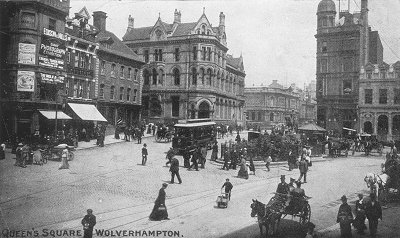 |
In this postcard view of Queen Square from 1902,
note the private carriage in the foreground with a top-hatted
coachman. In the right background can be seen the cabmen's
shelter and some cabs. These cabs are "growlers" (four wheel
hackney carriages) not "hansoms" (two wheel hackney carriages). |
Hansoms, though mostly made in Wolverhampton, were mainly used in London.
Growlers carried more people and more baggage but were slower.
| This postcard shows the Market Square at the
beginning of the 20th century. It seems not to be a market day
but even so there are a lot of horse drawn vehicles to be seen,
including a covered goods wagon moving towards the wholesale
market on the right. |
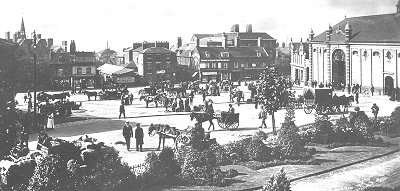 |
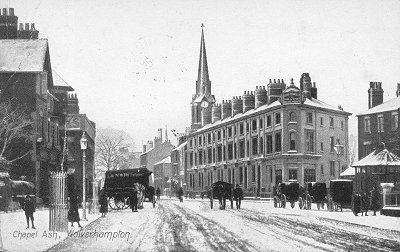 |
A wintry day in Chapel Ash. A horse drawn LNWR
delivery van is on the left. On the right is a cabmen's shelter
and three growlers. These shelters not only provided a seat and
warmth but usually served hot drinks and hot meals. |
The better class of carriages were largely made in London, where the demand
from the upper classes was greatest but local makers, including those in
Wolverhampton, would have made almost any sort of carriage to order. As the town
grew and prospered there would have been an increasing market, as horse drawn
vehicles of all sorts were in use.
| This old print, from Knight's Pictorial Gallery of
Arts, circa 1860, shows a coach builder's workshop. The things
hanging from the walls seem mostly to be templates - so some
repetition work was expected. The body and the chassis were
always built separately and usually one at a time to order. But
Forder seems to have introduced a production line principle to
cope with the numbers of Hansom cabs they were making. |
 |
Records become more abundant and revealing towards the latter half of the
19th century and in Wolverhampton they tell us something of the carriage making
trade. They seem not to have been fully researched but Patricia Hughes' work on
the Dixon's Building in Cleveland Street incidentally revealed a good deal about
the firm which was, by a long way, the biggest and best known of Wolverhampton's
carriage makers, Forder.
|

|
|
Find out about Forder |
Forder were not the only carriage builders in Wolverhampton. The town was a
good spot for their purpose - skilled workers, timber, iron, leather, paint and
varnish (all the ingredients of a coach), as well as a market amongst the
prospering industrialists, were all there. You can find a number of them in the
local trade directories and some of their advertisements, from various sources,
are shown here.
 |
This advertisement is from Melville's Directory of
Wolverhampton, 1851. Cund and Masefield are "opposite the centre
gate of the cattle market". They not only make carriages,
gigs, dog carts and traps but, even at this date, they make
"omnibuses".
They are not only manufacturers but "they always have on sale
a large and select stock of new and second-hand carriages of all
descriptions." They also carry out repairs "in the best
manner on moderate terms"; they provide you with a carriage
while your own is being repaired; and they hire out carriages.
In fact they seem to operate very much like a modern car dealer.
Most carriage makers also hired out vehicles. These
were usually second hand. When they got really old they
were often put to use as hackneys.
|
|
This advert is from a trade directory of 1870. Presumably
William Cund is the same man, Masefield having left the partnership.
In the 19th century many partnerships were short lived affairs and
firms changed their names quite frequently. William Cund's premises
were now "next building to the Agricultural Hall". There seems to
have been a concentration of carriage builders in Cleveland Road.
|
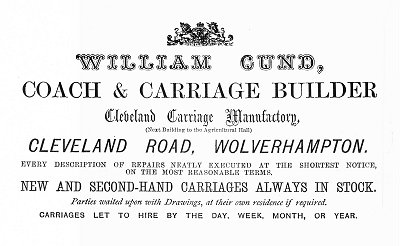 |
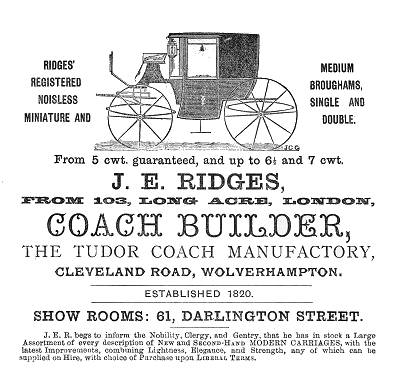 |
This advertisement comes from 1878. The Tudor Coach Manufactory was
almost certainly the building in Cleveland Road which was eventually
taken over by Forder (and is now part of the Dixon Building).
Note that Ridges had a separate show room in the shopping area of
the town centre. Whether he still had premises in Long Acre, London,
is left somewhat unclear!
|
| In the advert above J.E.Ridges claims to have been
founded in 1820. In this advert, from 1902, Ridges and Sons
claim to have been founded in 1890. Presumably it is the same
family. |
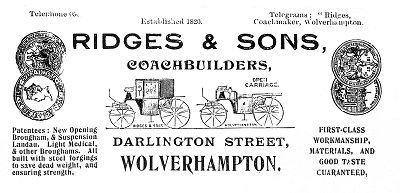 |
In the 1902 Exhibition Ridges exhibited "small square fronted brougham,
medium square opening brougham, "Barker" shape circular ditto, light canoe
landau, Parisian victorian, specimens "S.T.", "Pioneer", "Ideal", "Britain's
Best" solid rubber tyres. (Solid tyres remained in widespread use long after the
invention of pneumatic tyres because it was thought, mistakenly, that they
rolled more easily and took less effort to pull).
It is interesting to note that some railway carriages were made at the Tudor
works. But the carriage makers never evolved into that line of business,
probably because the railway companies took to doing it themselves. Nor did they
get into car making, even though many early cars had bodywork which revealed
that they were truly horseless carriages. It seems that this too would be
because the car makers made the car bodies (as they usually made every other
part) for themselves. One feels that as the carriage building trade declined and
the car building trade increased, workers, who certainly had transferable
skills, would have moved from one type of company to the other.
An obvious exception to most of this seems to be the Charles Clark company,
who seem to have evolved from selling coaches and carriages into selling
horseless carriages. All further information on their history would be
gratefully received.
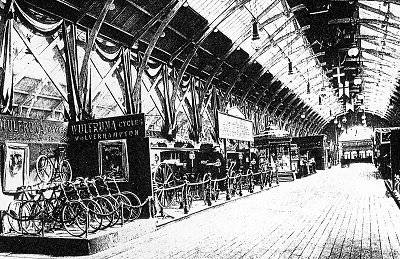 |
This old photo is of the Wolverhampton
Exhibition of Industry and Arts, held in West Park in 1902. Next
to the Wulfruna bicycles stand is the stand of Charles Clark,
with a display of their carriages. The Exhibition catalogue says
that they have a "selection of carriages, consisting of
broughams, victorias, four-wheel dog cart and Ralle cars, model
horse, harness". |
| This advertisement from 1914 is a reminder that
you could rent or hire horses and carriages of all types from a
livery stable. Even well off people would need to do this
occasionally. They might do this for the benefit of their
guests. Or they probably would not keep their own coach for long
distance travel and might prefer to hire one rather than commit
themselves to hoi poloi in the stage coaches. |
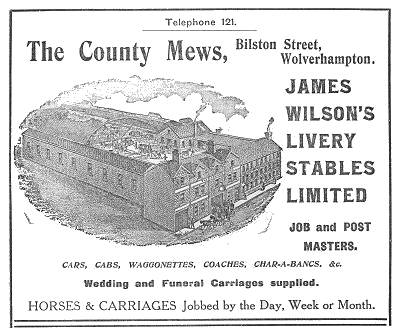 |
During the First World War 1914-1918 the Government requisitioned almost
every horse in the country for the war effort. But there was also an
enormous increase in the use of motorised transport and many soldiers learnt to
drive. After the war motorised transport, for private and commercial use,
increased greatly. All of this probably killed off the County Mews and
many firms like it.
|



